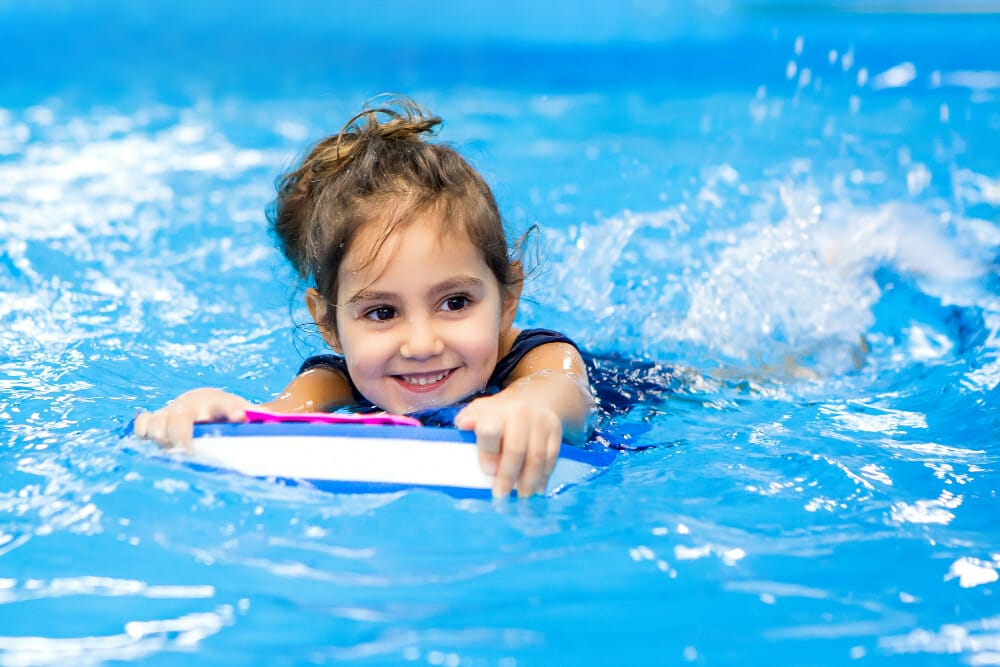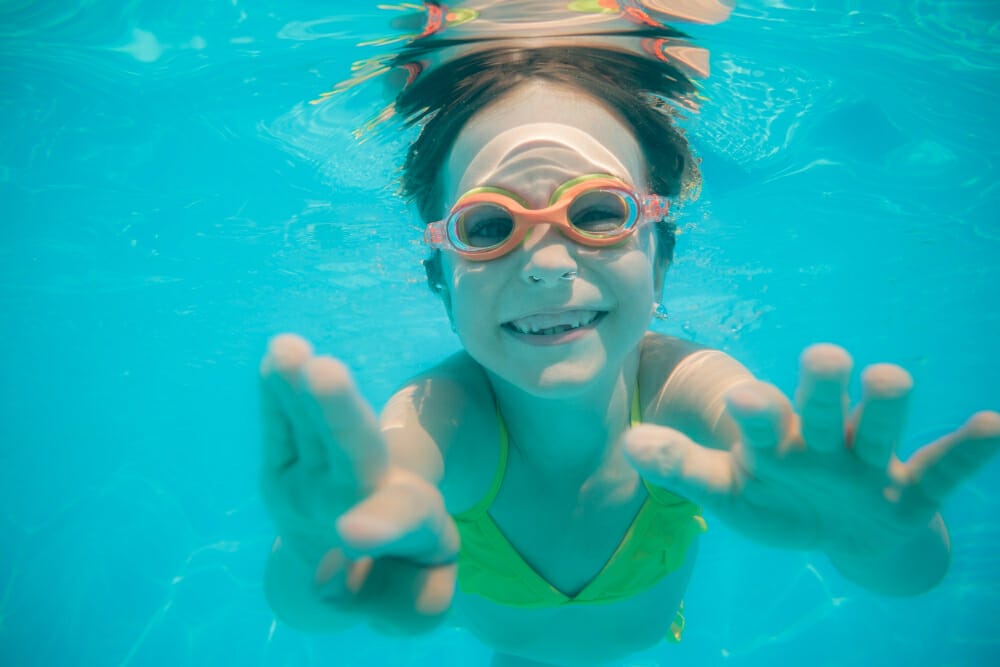Now that summer is finally here, swimming is a fantastic way to get your child moving while simultaneously developing so many other skills that are used outside of the water! Through water play, kids are able to move their bodies more freely and acquire foundational motor and sensory processing abilities that can later be implemented on land. As a former lifeguard and water safety instructor at a summer camp, I was able to see firsthand the benefits of aquatics for children with varying abilities. Swimming activities provide a fun, supervised environment for kids to release any tension or pent-up energy from the day while also indirectly targeting strength, coordination, creativity, socialization, self-esteem, and safety skills. Additionally, swimming offers an extremely sensory-rich experience for kids and is often therapeutic in that it can help to reduce any symptoms that may be interfering with a child’s day-to-day function.
Many children who demonstrate decreased body awareness, struggle with sitting still, or seek bear hugs and deep pressure can utilize aquatics to regulate these symptoms. This sensory processing skill is called proprioception, which is the body’s ability to sense its position in space through deep pressure to the muscles and joints. The resistance and viscosity of the water provides continuous deep pressure, which can be extremely calming for kids who are seeking this input. Children are also able to meet their vestibular needs in the water through linear, orbital, and rotary motions and unusual positions of the head, such as hanging upside down against gravity. Vestibular processing is the body’s ability to sense movement patterns and spatial orientation. You might notice your child seeks out vestibular movement by gravitating towards spinning activities such as a tire swing. On the other hand, you might feel your child becomes uncomfortable or steers away from these uncommon types of movement patterns and positions of the head that provide significant input. Either way, aquatics will provide your child with the vestibular input they require to grow their robust sensory systems.

Below is some information along with activities that highlight the benefits listed above, all while having a blast in the water!
Strength/Stability
Swimming requires use of nearly every muscle in the body, so it’s a great way to work on your child’s overall strength! Prone (belly down) and supine (belly up) water activities can have extreme benefits on postural strength and core stability. By developing the muscles of the core, children will likely see improvements with functional activities that require use of the upper extremities and hands. Flotation devices such as kickboards, barbells, and blow up toys can be helpful for children who need extra assistance aligning and supporting their trunk.
- Make a “boat” out of a float or raft to challenge your child’s core strength. After having fun constructing your raft, be sure that your child is sitting up tall and challenge their strength by having them reach overhead for items and return to center of gravity
- Sit on blow up toys to challenge upright posture and shifting center of gravity
- Have your child hold on to the pool ledge like their favorite superhero and inch their way across the entire length of the pool
- With extended arms, have your child hold on to a kickboard, barbell, or noodle while kicking their feet to challenge core and lower extremity strength
Coordination and Motor Planning
Swimming is a great way to challenge your child’s bilateral coordination and motor sequencing skills as they learn different strokes and ways to navigate the novel aquatic environment. Another important skill is learning how to motor plan and safely enter and exit the environment.
- Encourage kids to propel themselves with alternating movements of arms and legs
- Make an obstacle course with various water toys to encourage creativity while challenging novel motor planning and coordination skills
- Have a water balloon toss
- Play water games that require significant coordination such as volleyball, basketball, tag, relay races, etc.
- Practice safely navigating the aquatic environment with use of immediate surroundings (ex: stairs, ladders, railings, flotation devices, side ledge)
Fine Motor
There are so many ways to target your child’s fine motor skills during water play. Most water toys can be used for this skill area and are often extremely motivating for kids.
- Shoot water guns or squeeze spray bottles
- Toss a few sponges into the water and have your child squeeze the water into a bucket
- Cut pool noodles into discs and thread the disc on to a rope
- Squigz are one of my favorite ways to challenge fine motor strength and coordination skills. Stick a few of these on various surfaces and have your child swim and retrieve them, make a game out of it!
Emotional Regulation and Breath Control
Children can apply learned controlled inspiration and expiration skills used in the water to everyday life when attempting to regulate their own emotions.
- Blow bubbles to regulate breathing patterns. If your child is sensitive to water splashing their face, have them blow through a straw first!
- Float on back with one noodle under the armpits and another noodle under the knees, focusing on controlled breathing (“in through the nose smell the flowers, out through the mouth blow out the candles”)
- Float on back without support and focus on the breath. Remind your child to keep their hips towards the surface, as their body will begin to sink once their hips drop!
Sensory Processing and Reflex Integration
The aquatic environment offers many opportunities for kids to enhance their tactile, auditory, visual, oral, vestibular, and proprioceptive systems. Children with retained primitive reflexes also benefit from aquatics. Primitive reflexes are involuntary responses to sensations that typically disappear within the first year of life. However, sometimes these reflexes are retained and interfere with daily function, and this is where occupational therapy and reflex integration exercises can help! Swimming can assist in the creation of new neural pathways that discourage abnormal movement patterns and tone, improve body awareness, and increase coordination and reciprocal movement on both sides of the body.
- Ease your child into getting their face wet by making a game out of placing different parts of their face in the water one by one (nose, ear, lips, forehead, etc.)
- Splash around with other kids
- Swim vests for added deep pressure
- Sit and bounce on noodle for vestibular and proprioceptive input
- Jump, dive, spin, log roll in water with or without assist for vestibular input
- Swim to bottom and retrieve items against resistance for proprioceptive input
- Blow bubbles for relaxation and oral motor input (use straw at first if needed)
- Breaststroke, front crawl, or stomach crawl in shallow water (ex: along beach shoreline) to encourage decreased response of retained asymmetrical tonic neck reflex (ATNR)
- Back crawl to encourage decreased response of retained tonic labyrinthine and spinal galant reflex
Visual Perception and Attention
Work on your child’s visual and attention skills with different water games!
- Horizontal and vertical scanning for items that can sink to the bottom of the pool (ex: pool diving rings)
- iSpy for different items in aquatic environment
- Relay races (attending to when it’s their turn/waiting to be tagged by team mate)
Swim App
American Red Cross conveniently offers a free swim app to teach your child water safety skills through videos and activities. Parents can track their child’s swimming progress and skills through the app as well!
Have fun out there and be safe!
References:
Cole, A. J., & Becker, B. E. (Eds.). (2004). Comprehensive aquatic therapy. Butterworth-Heinemann.
https://www.redcross.org/get-help/how-to-prepare-for-emergencies/mobile-apps.html
http://www.movetolearn.com.au/wp-content/uploads/2017/06/WetMovetoLearn.pdf

